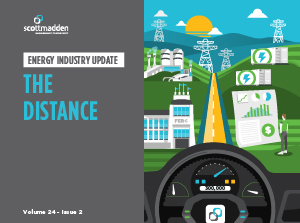Insights
Featured Insights

The Foushée Security and Compliance Compensation Survey Now…
ArticleSecurity leaders who desire fair compensation for their team should consider sending this information to their HR or compensation department since these are the staff groups that…
READ MORE
The Energy Industry Update – Volume 24, Issue…
Energy Industry UpdateScottMadden's fall 2024 edition of the Energy Industry Update, is themed "The Distance." The report dives into the pressing issues of renewable resources, extreme weather, and energy…
READ MORE
2023 Corporate Responsibility Report
ReportThis annual Corporate Responsibility Report details the actions ScottMadden took in 2023 to address important societal and environmental sustainability issues that are material to our business operations…
READ MORE
Maximizing Cost Savings Through Finance Shared Services
ArticleFinance shared service centers can generate significant cost savings for organizations that are willing to invest in building and maturing them over time. Learn how top performers…
READ MORE
Governance and Global Models in Finance Shared Services
ArticleStrong governance is critical for an effective SSO. Learn how top-performing SSOs are building their governance structures to allow for successful implementation and growth.
READ MORE
Automation and AI in Finance Shared Services: A…
ArticleManual tasks take your finance organization too much time. Learn how companies like yours are incorporating automation and new AI technologies to operate more efficiently in our…
READ MORE
Evolving Financial Operations: Insights from the 2024 Financial…
ArticleScottMadden's and APQC's 2024 finance shared services benchmarking study gathered data from respondents in 103 SSOs across delivery model and operations, staffing, SSO management infrastructure and technology,…
READ MORE
Employee Spotlight: Brijae Harper
Employee SpotlightBrijae Harper is a senior analyst with ScottMadden and has been with the firm since 2021. She works primarily on the C&SS side, as well as doing…
READ MORE
Surging Large Loads: Challenges and Opportunities for the…
ArticleAfter a period of relative stagnation, peak demand and energy growth forecasts are soaring, driven by massive new manufacturing initiatives, the explosion of data centers, and the…
READ MORE
Energy Central Power Perspectives Podcast: The Future of…
ArticlePartner Stephen Haubrich was a guest expert on the Energy Central Power Perspectives podcast, to discuss federal funding considerations for energy utilities.
READ MORE
The Foushée Security and Compliance Compensation Survey Now…
ArticleSecurity leaders who desire fair compensation for their team should consider sending this information to their HR or compensation department since these are the staff groups that…
READ MORE
Practical AI for Utilities: How to Prioritize and…
ArticleUtilities can move beyond experimentation to achieve operational improvements and set the stage for sustained innovation through their approach to selecting, prototyping, and scaling AI use cases.
READ MORE